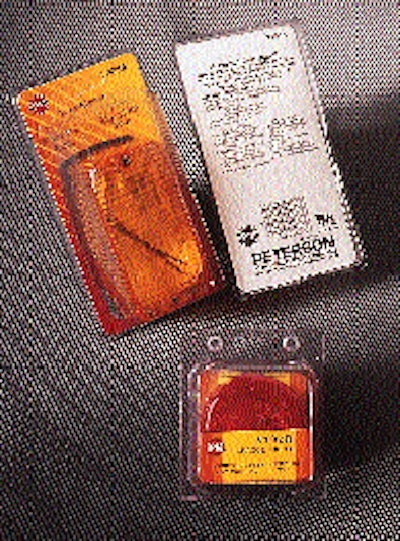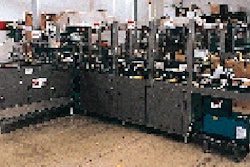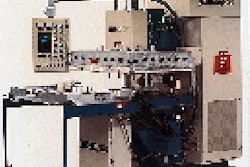It was bad enough when a fierce competitor of Peterson Mfg. Co. moved its production offshore, slashing costs and underpricing the Grandview, MO<>based maker of automotive lighting products. To hear manufacturing engineering manager Tobe Tennyson tell it, the competitor crossed the line of propriety when it issued a challenge to Peterson Mfg., daring the company to try to keep up. "They made a damn mistake by challenging the president of our company," says Tennyson. "He came to me and we started to look at changing our packaging operation." Peterson's production costs were highly competitive, but its labor-intensive packaging costs-loading products and blister cards into plastic fold-up clamshells-were hurting the bottom line. Peterson snapped into action. Working with blister and machinery supplier Alloyd (DeKalb, IL), Peterson redesigned its package to save on material costs while updating the look. Peterson also automated the packaging operation with a 16-station blister heat sealer purchased from Alloyd at Pack Expo 94. Peterson was familiar with Alloyd from past projects. The new blister pack is unique in that it combines the look of a clamshell with the economics of a blister card. The 12- to 15-mil polyvinyl chloride blisters, thermoformed by Alloyd, not only cover the entire surface of the face card, they extend beyond the back of the card with 3/8"-W protective flanges. It's called a platform blister because when the package is set on its back with the product facing up, the card acts like a raised platform. By "burying" the card 3/8" into the blister, it makes pilferage harder and protects the edges of the card from becoming dog-eared. The plastic on the face card also reinforces the die-cut hang hole, preventing it from tearing. Alloyd's Kent Hayward says the supplier has never created such a package before. Not only does the pack provide the same degree of protection as the clamshell, it can be automatically heat sealed on Peterson's 16-position carousel blister machine. The clamshell had to be manually loaded. The new machine automates the entire packaging process except for product loading. Though the machine is standard for Alloyd, it gives Peterson the unprecedented opportunity to boost production. Costs plummet By March '95, within three months of receiving the machine, Peterson and Alloyd had come up with the new blister design, and production in the new pack had started. Packaging costs did indeed drop, on the order of 4¢ to 10¢/package. Output took off, averaging about 3길 packs/hr, compared to 300/hr previously. Tennyson estimates the machine paid for itself the first year. Aside from improving productivity for product previously packed in clamshells, the new package style also improves upon Peterson's previous blister card packaging, which had been used for about 30% of its product line. While there was no cost savings compared to the blister cards, the new package protects the card-and the hang hole-from being torn. Retail outlets such as Wal-Mart and auto parts stores had been returning about 4% of Peterson's blister-carded product due to torn cards or weak seals, which had invited pilferage. Today, retail returns due to bad packaging have dropped to under 1%. And the platform blister is more resistant to pilferage, since the extended flanges make it harder to reach in and peel away the card from the plastic. Peterson was also able to reduce package sizes, permitting more SKUs to fit into a given display area. Twelve cards (and blisters) are used for some 40 SKUs, with new SKUs being added continually. Automatic functions Although Alloyd refers to the machine as a carousel-style heat sealer, it's not a rotary machine in the strictest sense. However, there are 16 positions that cycle through the various functional stations, including blister placement, manual loading, card placement, heat sealing and ejection. Each of the positions has a nest that holds anywhere from two to six packages. Nearly all functions are automatic. "The only thing we have to do is drop the product," says Tennyson. Packaging starts out as a vacuum-assisted die-cast plug pulls nested, thermoformed blisters with pre-cut hang-tab holes from a magazine and deposits them upside down into holding areas, or nests, in the table. At the next station, operators load product manually. While Peterson typically uses just one operator to load product, there's enough room in the loading area to add as many as four people during crunch times, or for products with many components. "There could be two or three items in a given package, which means I'd need two or three people in there loading product," says Tennyson. Blisters advance to the automatic blister card feeder which dispenses cards upside down. The 21-pt SBS cards are printed offset in three colors plus waterborne heat seal coating by Andex Industries (Escanaba, MI). The cards are printed with Peterson's generic decoration and are die-cut with a hang-tab. Peterson then batch-prints product-specific information on the front and back with an existing metal die press. (High-volume cards are supplied with preprinted backs.) At the next station, cards are heat sealed over a three- to six-second dwell. Cards are coated with a water-based adhesive. Matched heat blocks precisely seal the blister front to the card. A vacuum cup mechanism picks packages out of the nests and places them on a takeaway conveyor. According to Tennyson, the accuracy of the blisters is critical to the product loading. "We need perfect blisters-cut on center, sharp corners, coated to separate easily. If you don't get accurate parts and you're trying to automatically feed blisters, you really have a problem," he says. "Also, blisters have to be very precise in their dimensions to bond properly." It's also helpful that both machine and material come from a single source, says Tennyson. Quick-change tooling Designed for fast changeover, the machine permits nests dedicated to each pack size to be changed easily and quickly. "We can go from one blister card to another in 15 to 20 minutes with two people," says Tennyson. "It's all quick-change tooling. You just pop a cotter pin out, pull one nest out and put another one in." The platform blister was a solution that works well for Peterson, and was preferred over alternatives such as skin packaging. "We just don't like the appearance of skin packs," says Tennyson. "We like the crispness of this package. We went to a platform to protect the card, and it's helped us to get away from rejects. Plus we're able to get our packaging out of the '60s and into the '90s."























